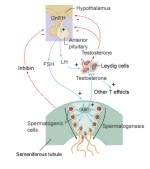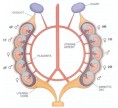 |
The onset of puberty is a brain event rather than a gonadal event. Based on both internal and external signals, the nervous system initiates gonadal maturation to complete the process of sperm and egg development as well as stimulate structural changes in regions of the adolescent brain. White matter volume increases through adolescence while gray matter first increases and then decreases to the adult volume in the early to mid 20's. Hippocampal and amygdalar volumes increase in a sex-dependent manner, with hippocampal enlargement occurring only in females and amygdala enlargement only in males.
Gonadal hormones organize numerous neural circuits and behaviors during adolescence. Adolescence is clearly pivotal for behavioral development, especially in view of the potential for hormones to permanently affect the brainís capacity for change.
A particularly exciting and controversial discovery of a link between sexual behavior and brain structure concerns homosexuality in humans. Simon LeVay, then at the Salk Institute for Biological Studies in San Diego, reported that the size of a nucleus in the anterior hypothalamus of homosexual men more closely resembles the comparable structure in women than that in heterosexual men.
Daughters born with a male co-twin had a reduced lifetime reproductive success compared to those born with a female co-twin, both because such daughters experienced a lower chance of marrying as well as producing fewer children. Nutritional and social factors did not affect the results, leading to the conclusion that exposure to testosterone from adjacent male fetuses in utero affected the reproductive success of the daughters.
 |
In species that produce litters of many young from each pregnancy, the fetuses are arranged like peas in a pod inside the uterus. This grouping results in female and male fetuses residing next to one another in random order. Steroid hormones produced by one fetus's gonads influence the developing neural and secondary and accessory sex structures in an adjacent fetus, as shown by studies of rats, gerbils, and mice.
The hormonal environment of the embryo influences the animal's adult sexual behavior by helping to organize the sexuality of the brain. In vertebrates steroid hormones act directly on specific neurons that are linked together in circuits. A nucleus of cells in the gerbil brain, present only in males, lies embedded in an area that helps to control copulatory behavior in male gerbils. Female gerbils injected with androgen early in life develop this "male" nucleus and take on some male behavioral characteristics.
Pubertal hormones organize the adolescent brain and behavior, Male twins reduce fitness of female co-twins in humans
Crews, David. 1994. Animal Sexuality. In Vista in Readings. Scientific American Magazine. (January): 108-114.
Click